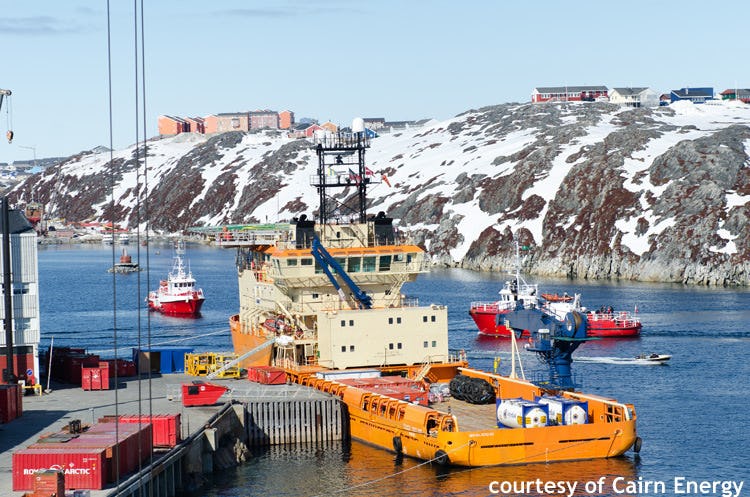Greenland Releases Oil Spill Plan - U.S. Coast Guard Lacks Arctic Response Capabilities

Toisa Vigilant in Nuuk, Greenland. Photo: Cairn Energy
Greenland’s government released Cairn Energy PLC’s oil spill plan for its deep-water operations off the west coast of Greenland. Cairn won drilling rights in May 2011 and may drill up to seven exploratory wells. The Scottish oil company’s contingency plan was published on a government website.
Greenpeace and other environmental organizations have continually criticized drilling operations in the fragile Arctic environment and reiterated concerns about the lack of oil spill response capabilities. According to comments made by Joern Skov Nielsen, deputy minister at Greenland’s Bureau of Minerals and petroleum, Cairn is capable of handling spills up to 10,000 barrel a day; the plan however is based on a 5,000 barrel-a-day spill. In comparison, the 2010 BP oil spill in the Gulf of Mexico released up to 57,000 barrels a day.
The plan also contains measures to protect drilling rigs and equipment against icebergs and floating ice sheets along Greenland’s west coast, also known as “iceberg alley.” As Arctic melting continues more and larger chunks of sea and land-based ice may find their way into the Atlantic and ice-protection measures may yet prove to be inadequate.
In an effort to prevent continued harassment by Greenpeace ships, the exclusion zone around oil rigs has been expanded from 500 meters to 5 kilometers. The Danish coastguard is expected to dispatch vessels to prevent Greenpeace from approaching or boarding the oil rigs. Besides Cairn Energy, bigger rivals such as Exxon Mobile, have acquired exploration licenses in Greenland and are expected to start drilling.
Arctic response capabilities were also discussed by U.S. Senate Subcommittee on Oceans, Atmosphere, Fisheries and Coast Guard, chaired by Sen. Mark Begich (D) of Alaska. Shell Oil has applied to drill exploratory wells next year in the Beaufort Sea and Chukchi Sea off Alaska’s northern and northwestern coast.
The company’s spill response plan lists more than a dozen vessels accompanying the drilling ship, a second drilling ship to relieve pressure in a blowout well, and an oil spill containment system that could cap a blowout. The Coast Guard has been working closely with oil companies and informing them about their responsibilities in the event of an oil spill.
Ultimately, however, says Adm. Robert Papp, Commandant of the Coast Guard, responsibility for spill cleanup lies with his agency.
Currently Coast Guard Arctic capabilities are extremely limited. The Coast Guard’s heavy icebreakers Polar Star and Polar Sea have both been decommissioned and the only remaining icebreaker, the Healy, is not capable to sail through the region’s thick winter ice. The agency plans to reactivate the 35-year-old Polar Star by 2013, but the Coast Guard’s Arctic capabilities are dwarfed by Russia’s fleet of six nuclear icebreakers. China recently commissioned construction of a second $300 million icebreaker expected to enter service in 2013.
At a time when Congress is looking to make major spending cuts, the Coast Guard will be expected to take on a new range of responsibilities. Arctic melting not only opens the door to resource development, but also to commercial shipping and tourism.
The Coast Guard base nearest to the drilling sites and future shipping lanes is located in Kodiak, more than 1,600 kilometers away. Adm. Papp stated that “we do not have any infrastructure on the North Slope to hangar our aircraft, moor our boats or sustain our crews. […] Prudence dictates that we also acquire an appropriate level of Arctic pollution response capability. Presently, we have none.”
The issue of Arctic response capabilities is also being addressed by the Arctic Council’s Emergency Prevention, Preparedness and Response working group.